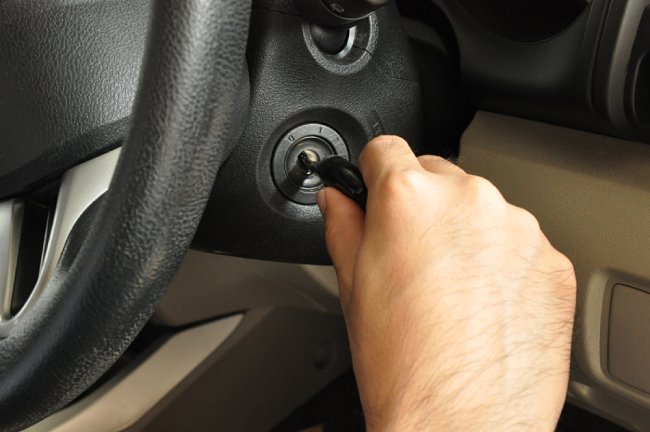We all take for granted that the car will start when we turn the key in the ignition. But what happens when you turn the key and your engine doesn’t turn over?
Let’s explore a bad ignition switch and how to start your car.
How Does An Ignition Switch Work?
Three important parts are dependent on the ignition switch as it supplies and controls electricity flow through them. These parts are…
- Battery
- Starter
- Ignition coil
The battery supplies the power when the starter starts the engine and the coil makes sparks for ignition.
A lever, which engages both sides of the gear teeth of the starter drive shaft is pulled after electricity passes to the starter solenoid through a wire when you turn your ignition key on.
Turning on the key also turns a switch, which supplies current to the ignition coil. The coil produces intense pressure and heat by converting the electricity and thus creates a spark.
A small pocket situated in each cylinder, which contains fuel/air mixture is ignited by this spark. A drive shaft is turned and the piston goes down as a result of this combustion force. Ultimately the power is generated this way to move your car.
How Does An Ignition Switch Go Bad?
Water is the most common cause of problems with ignition switches. It can make your switch corrode over time, which leads ultimately to the failure of the switch.
A loose connection is another common problem of a bad ignition switch which results in intermittent electrical failure.
Performing regular maintenance can prevent most of the problems. To make sure your ignition system is ok, it should be checked at least once a year.
Signs of Bad Ignition Switch

1. Stalling car
If you start your car and it stops while the key is in the ‘0n” position, this is a stall.
This can happen many times or just once or twice. Make sure to look into this; this is not normal.
2. Key won’t turn
If the key doesn’t turn when it is in the ignition, it could be the ignition switch.
3. Key stuck in the ignition
If the key gets stuck when you put it in and can’t pull it out, this could be an ignition switch issue.
4. Can’t start the car
The engine won’t roll over when you turn the key; get this looked at right away.
5. Car stalling out of nowhere
The car starts, and while driving, the car stalls; this needs to be looked at, especially if it happens more than once.
6. Stuck steering wheel
If the steering wheel is stuck, turn the wheel (You may have to turn it side to side a few times) and turn the car on, this should unlock the steering wheel.
The steering wheel lock engages when you turn the car off so car thieves can not drive the car without your keys.
7. A silent starter
You start the car, and there is no noise. Your engine does not come on. You should hear the engine start.
This could be a dead battery or an electrical issue. Have this looked into as soon a possible.
8. Worn out key or ignition cylinder
Sometimes you can wear out a key. You use it all the time, so there is a good chance it will wear out.
Keys with heavy keychains can speed up the process of wearing out your key of the ignition cylinder.
The key will fall out of the ignition, or when it goes in, it won’t turn. The ignition cylinder may need to replace the ignition cylinder, lock, and key. This needs fixing today.
9. Flickering dashboard lights
You are driving, and your dashboard lights start to flicker.
Chances are it has nothing to do with the ignition switch, but since it could be, have it checked out just in case.
10. Immobilizer issues
Today’s car keys have a chip that matches a code in the ignition. When the code or the chip doesn’t work, you have an immobilizer issue.
If the codes don’t match, the car won’t turn over. There’s a number of reasons why it happens.
You can’t fix this problem, so take it to a dealer and have them reprogram the key.
Once in a while, you may have more than one key on your ring with a code. So your car may be confused about which key is supposed to start it.
11. Powering vehicle accessories issues
You turn on the car, but the radio and windshield wipers won’t work.
This may have to do with the ignition switch interfering with the power going to the accessories.
You don’t want to be driving in the rain without wipers.
Ignition Switch Problems Diagnosed
1. Right car/right key
If you have put the wrong key in your ignition, chances are it is stuck.
Make sure the car is off and try to remove the key. Move the wheel to both sides while turning on the car.
2. Wrong positioned gears
When you turn on the car and press the brake to put it in gear, but nothing happens, the ignition switch may be the problem.
3. Test the light
Keep the engine off while testing the light.
First, ensure the ignition switch is not on. Next, find the connector for the module wire and disconnect it.
Once this is done, find the starter solenoid S terminal and disconnect it. The engine should no longer turn over when the key is in the run position in your ignition.
Put the ignition in the run position when you turn the ignition key, leaving it in RUN. Then, using the test light lead, find the ignition coil’s battery terminal, place the lead on the RED wire connection, and test the voltage.
Put the ignition in the start position when you turn the ignition key, leaving it in START. Then, using the test light probe, find the ignition coil’s battery terminal, place the lead on the WHITE wire connection, and test the voltage.
No voltage means the ignition switch needs replacing.
How to Use a Multimeter
Using a Multimeter can be done in a few different ways:
Number one
On the multimeter, you will need a reading of 90% or better to know that the ignition switch is good.
To use the Multimeter, turn the ignition switch off.
Next, find the power feed wire on the module and place your positive multimeter lead on it.
Place the ignition key to run, and check the voltage.
Number two
You will need to open the fuse box under the steering wheel and open it. Remove the fuse for the starter signal, look for damage or burns, checking the metal strip thoroughly.
If you need to replace it, do so now, be sure to use the correct amperage.
After opening the hood, put the multimeter BLACK lead onto an unpainted metal part like the car’s frame. The RED lead goes on the positive (+) battery terminal.
Next, turn the dial to the volts sign. A reading of 12.6 and higher means the battery voltage is good.
Turn the ignition key; when the engine starts, the ignition switch is working.
A clicking and the engine won’t turn over; the problem is not a bad ignition switch. If you do not hear the clicking, it IS the ignition switch, and it will need replacing.
Number three
If voltage is not getting through the spark wire, the ignition switch won’t work.
To check this, you will need to place a spark plug wire close to a metal surface and listen for crackling noise or look for a spark after turning on the engine.
No spark or crackles mean no voltage is coming through could mean you have an ignition issue.
To check positive terminal voltage, place the multimeter’s RED probe on the terminal coils positive side/BLACK lead to the battery terminal left side.
Check the multimeter reading after putting the ignition in the run position. A reading that is low or does not register means you have a problem with either the ignition switch or its wiring.
Security system checks
The Anti-theft system in your car can malfunction and cause the car to stall or not turn on at all.
Make sure the batteries in the key fob are good. If the fob isn’t the problem, this is a dealer issue.
How to Start a Car With a Bad Ignition Switch
1. Hotwiring
This can only be done on older model cars!
Steering column cover removal
Find the screws that hold this plastic cover on, use a screwdriver to remove the screws.
Ignition switch plug location
The ignition switch connector should be hanging; look at the back of this for the connections, then you need to cut the wires, disconnect the connector or short out the wires.
Ignition switch wiring
This step is important; you need to understand the wiring or read the owner’s manual!
You will need to know the location of the positive battery wire (usually red), the starter (usually yellow) motor wire, and the ignition wire (usually brown).
Striping wires of the battery, starter, and ignition
Using a wire cutter, strip the plastic covering off all three wires.
Twisting the cables of ignition and battery
Watching for a slight spark, twist together the positive battery wire and ignition wires.
Checking if the engine on
When you twist the wires, you should hear the engine start (on some cars, you can even hear the fuel pump); if the car does not start, you have the wrong wires.
Holding the battery cables and then the starter together
Once the ignition starts, hold the starter motor cable and positive battery wire together until the car starts.
Pull these wires apart once it is started, but make sure your positive battery wire and ignition wire are still twisted.
Cracking the steering lock
Push screwdriver with force into the ignition and turn the wheel hard to each side.
2. Using a drill and a screwdriver
Note: use screwdrivers on older cars and drill on newer models
3. Looping with a jumper link and connecting the battery
Apply one cable to the positive side of the coil, the other to the positive terminal on the battery; you should have enough power from the dashboard to start the car.
Connect the positive battery terminal to the selenoid (after the ignition switch wiring is disconnected). As the solenoid is activated, you can start the car.
Fixing the Bad Ignition Switch
1. The DIY process
How to disconnect the battery
Loosen and remove the NEGATIVE battery cable. Leave the right one alone.
How to remove trims around the steering wheel
The plastic trim around the steering wheel comes off, it may have screws that need removing, or the plastic covers can be popped off with a screwdriver.
Removing the steering wheel
You will need to access the top of the ignition switch; if you can not get to this, the steering wheel will need to come off.
Using a vehicle-specific manual, you need to remove this to ensure you do not destroy the steering column. This may require a unique steering wheel removal tool.
Releasing the ignition module clip
Have a screwdriver ready in case it is needed. There are release clips on each side of the ignition switch (It looks like a plastic cover around the ignition module).
Press on each side of these clips to release them; it may be easier to use a screwdriver to push the top release down.
Once this is done, slide the cover off the ignition module.
Turning the ignition to “accessories” by inserting the key
Put in the key, turn it to accessory mode, and turn it (If you don’t have the key, a screwdriver works the same).
Using the release pin on the ignition module
The release pin located in the ignition module (the area is thinner than a pencil).
You will need something sturdy that is long and thin enough to fit in this area and push down the release pin.
The ignition switch slide out
Hold down the release switch while sliding the ignition switch out.
You can use the screwdriver to press the clips if you have bigger fingers.
Using the same key after rebuilding your ignition switch
Once the ignition switch is rebuilt, you can use the original car key!
Ignition switch sliding into it
The new switch gets dropped into the hole where you removed the old. Make sure you align this so the release pins and the grooves on the ignition module match up.
The release pins will click in place when it’s in the proper position. Push on the switch if you don’t hear the click.
Testing the switch after reconnecting the battery
Replace the NEGATIVE battery cable to the terminal and tighten it.
Next, start the car to ensure everything is connected and working. If the car doesn’t start, remove the ignition switch and reinsert.
Warning: Make sure to disconnect the battery first!
Putting the dashboard together
Be sure to reinstall the steering wheel covers in the order they were removed, do not use force. Make sure to screw down the pieces that need to be resecured.
2. Still need the repair shop
After trying all the above, if the car still won’t start, you need a mechanic to fix the problem!










Leave a Comment